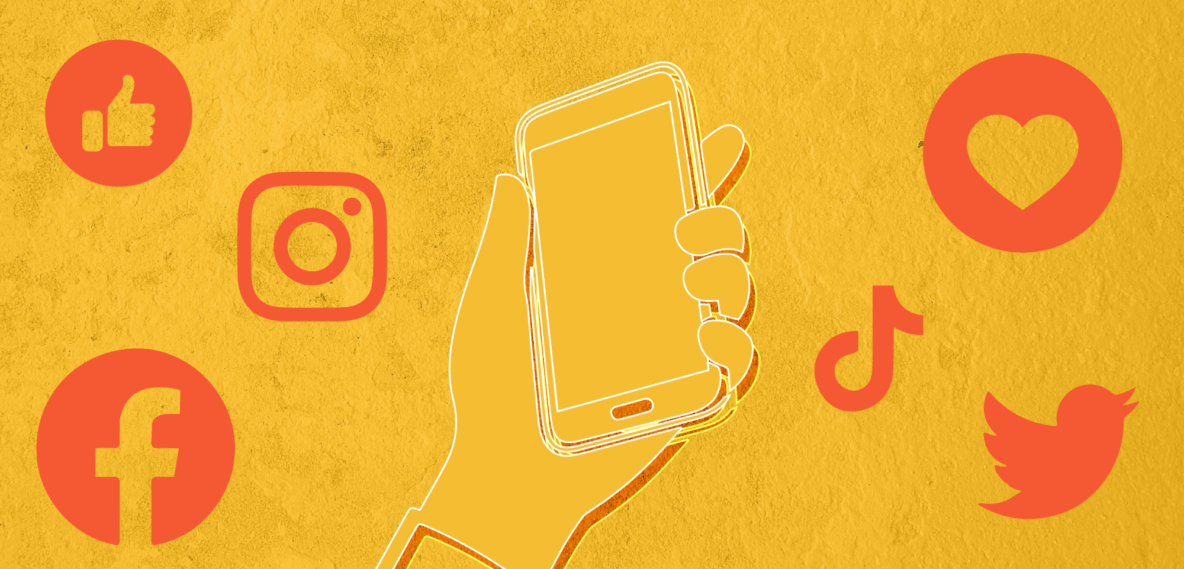Social Media for Parents: Where to Start?
Social media has become an omnipresent part of daily life. Regardless of how personally active we are on social media it’s a force that shapes us, our teens, and the world we live in. Because of it’s ever-changing nature, there’s always some new platform to figure out or something new to discover on a platform we already use. It’s normal to not have a grasp on every single tool, but sometimes we feel compelled to understand. Especially when we hear about some new trend that’s wreaking havoc on teen mental health or putting our teens at risk in other ways.
Because it can be seriously anxiety-inducing, we got to work on making a go-to reference for parents. We’ve accumulated a collection of resources dedicated to understanding the apps your teens are using better. We get into detail on weighing the benefits and threats of different social media, and explore the nuance of “internet friends”, “cyber-bullying”, “influencer culture”, and “social media advocacy”.
We’ve included summaries of each topic as well as links to our favorite resources so that you can do your own reading. Our aim is to offer a full scope of perspectives on social media from professionals in the field, clinical psychologists, real parents, and teenagers themselves.
How to use this guide
Firstly, we don’t expect you to read all of this at once (you can if you want to, though)! The idea of this guide is to access it whenever you come across a new term or need a refresher. This is a living database that we’ll update regularly to make sure it always covers key topics around social media.
It’s made to help you have informed conversations with your teen about social media and its use. We understand that it’s easy to be afraid or apprehensive about teen social media use. This guide is built to help you understand how it impacts teens all around - the good and the bad!
We’ve put together these resources to help you get familiar with how social media impacts teen mental health.
While some of this info might read as scary or anxiety-inducing, these articles are meant to provide you with some insight into the issues experienced by our teens in order to fully understand and empathize with the unique set of issues they experience today, worlds away from the society we grew up in as parents.
We’ve put together these resources to help you get familiar with how social media impacts teen mental health.
Social media 101: understanding platforms and terms
elcome to Social Media 101. We’re going to talk you through how and where to look for everything social media. This section is here to make sure you can always find what you’re looking for when it comes to social media-related info. We’ll run through the most popular socials, why your teen might use them, how to set up an account, how to keep your teens’ accounts safe, and what the heck the deal is with influencers.
Tiktok
TikTok has taken the world of social media by storm, changing up the format of what we think of when we think “social media”. The platform is based on short videos and a powerful search function, making it a powerful place to find content on an infinitely long list of topics.
Our Primary Article
Other TikTok Resources:
Instagram has been in the game for a while and while some parents are avid users of the network, some might still have their doubts. Instagram aims to be a visual storytelling platform, allowing users to express themselves primarily through images and short videos.
Our Primary Article
More Instagram Resouces
snapchat
To kick off our social media adventure, we’ll delve into the initiator of the 24-hour content format - Snapchat! Snapchat kicked off what we know as “stories” today way back in 2013, and since then, a lot of the other big networks have hopped onto the bandwagon.
Our Primary Article
Other Snapchat Resources
The final article by Snapchat talks about using the app safely.
bereal
Something fairly new in the realm of social media is BeReal, created to add a dose of “realness” to the oversaturated perfectionism across most social media channels. BeReal prompts its users to take a picture with their front camera and normal camera at a random time during the day and aims to show users’ day-to-day without the filter.
Our Primary Article
Other Resources on BeReal
Reddit has been around for a very long time now but stays out of the spotlight most of the time. Reddit is overall considered one of the less problematic social media networks and is used for sharing opinions and experiences. It’s based on a merit system where users have to gain credibility before being able to post in certain “subreddits”, or channels. Users can post or comment to gain or lose “karma” which then reflects on their profile.
Our Primary Article
Other Reddit Resources:
Twitter is the “grown-up” of social media networks, full of users from all walks of life, from celebrities to politicians and even, yes, teenagers. In case you aren’t familiar with the inner workings of the Twitter format, the idea is that all posts are limited to 280 characters. Twitter utilizes short bursts of creativity to make strong points without the fluff.
Our Primary Article
More Helpful Resources
- This article talks about fortifying your Twitter account using the platform’s privacy settings.
- This is Twitter’s official guide to setting up an account.
This guide goes into detail on Twitter’s various safety features.
Social media influencers play a tremendous role in shaping our teenagers’ internet experience.
The wonderful world of influencers
What it means to be a celebrity has changed a lot since when we parents were young. Instead of singers and actors on the silver screen, a lot of these celebrities are just “normal” people sharing their experiences and their style. Social media influencers play a tremendous role in shaping our teenagers’ internet experience. Influencers oftentimes serve as brand representatives, setting the standard for young people in things like beauty and trends. Because of this strong impact, we thought you might be interested in what experts have to say about the social power of influencers.
unpacking the influence of influencers
We have frequently discussed the plasticity of the teenage brain and the reasoning behind adolescents’ impulsive nature. Teenagers do not have the same self-control, behavioral inhibition, and critical thinking skills as adults, and are more prone to falling prey to influencers’ social influence. Because of that, we thought it would be useful to provide you with the resources to understand this social influence on a psychological level.
- This article delves into the darker side of influencing. As suicide rates have risen among young teenage girls, investigators have found that social media bears some responsibility for the downward spiral of teen mental health.
a deeper look at social media and mental health
This isn’t a new topic to the Teen Brain Trust or to most parents, but we wanted to include a look at the different things parents should be aware of when it comes to this. This collection of resources discusses the potential problems that come with social media, including mental health problems, cyberbullying, and catfishing.
The rates of depression, anxiety, and disordered eating continue to skyrocket in the digital age. These will be the three disorders we pay special attention to. Research has shown that social media has impacted these three disorders especially, but that they are easily remedied if parents intervene on time. The effects can be mitigated by having the right systems in place like a supportive environment and well-informed parents.
Depression
Anxiety
- The first article we wanted to share is also by the Child Mind Institute, talking about how the inherent differences between socializing online and socializing in person leave teenagers with significantly lower self-esteem and higher anxiety rates.
- Another 2020 study found that a lack of positive feedback in the form of likes and comments on social media decreases self-esteem and increases anxiety among teenagers.
Eating Disorders and Body Dysmorphia
Social Anxiety and Isolation
- This is a review from 2021 examining how socially anxious people use social media to avoid their social anxiety. Drs. O’Day and Heimberg explore this relationship and talk about future research.
Cyberbullying
Catfishing
Catfishing is the act of faking one’s identity online for the purpose of communicating with and even befriending other people. Catfishing is deceiving and can be dangerous, which is why it’s important for teens to take the proper precautions with their online friends.
the bright side - what are the associated benefits of social media?
While we’ve just gone into stark detail about the downsides of social media, it’s not all so bleak. This part of the article will delve into what makes social media an amazing thing to be a part of. We’ll talk about the value of social media in making new friends, connecting with communities, and advocating for vulnerable populations.
Social connection
Our first topic is social connection. Social connection is frequently cited as the single most valuable contribution of social media to modern society, particularly for adolescents. We thought it would be useful to compile some resources that have a more critical take on this perspective in order to kickstart this conversation with your teenager.
Identity Development and Self-discovery
These articles talk about identity development. Adolescence is a critical period for self-discovery and the internet plays a tremendous role in shaping our teens’ construction of identity and self-image. We wanted to provide insight into how to keep your teen safe and informed during this sensitive time of their development.
- Uhl’s group explores the potential benefits of teenagers using social media as a tool for learning about their autonomy, intimacy, aspirational development, and peer engagement. They also discuss potential costs and ways to mitigate the negative effects.
Advocacy & philanthropy
Next are some resources on online advocacy and philanthropy, as young people are increasingly becoming the voices of social change and charitable causes through the internet. We thought it would be useful to talk about how powerful social media can be in instilling a sense of power, independence, and social action in your teens’ lives.
- This article shares over a dozen examples of real-life teenagers using social media as a tool for positive change, including semester-long social justice campaigns and students creating apps for safety.
- This article also provides illustrious examples of real individuals who use social media and the internet to impact real, lifelong change.
- This article shares the power of social media as a tool for finding and getting involved in nonprofits. Almost half of young people have discovered nonprofits through social media.
Internet Friends
To wrap this guide up, we included resources on internet friends. Teenagers are meeting more and more new friends on the internet. We know that this can be unsettling and uncomfortable for parents as we learn to navigate the digital world, and we wanted to keep you as informed as possible on the surprising findings about Internet friendship.
- The first article shares a brief discussion of a recent study that found that digital interactions are just as important as in-person friendships, particularly in a few things (to get into the nitty-gritty, some are validation, companionship, and conflict resolution).
- Research conducted by the Pew Research Center found that the internet and social media are instrumental in cultivating friendships.
Share this Post

